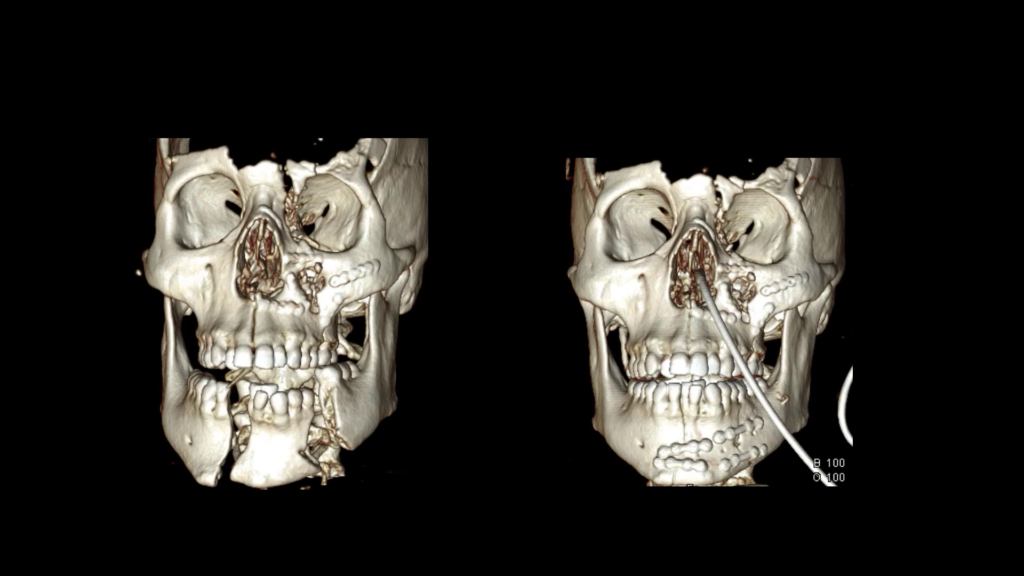Preop & Postop Images

Key Concepts:
1. Prioritization of Gunshot-Related Exploration:
- Airway and bleeding control take precedence over bony fracture repair.
- First, Secure the patient’s airway.
- Second, Control bleeding by ruling out great vessel injuries.
- Assess for airway injury (tracheal laceration) if the mechanism warrants.
- Assess for oral, pharyngeal, or esophageal injuries that can result in neck abscess/neck fasciitis and hardware failure. Plan for repairs (SCM or pectoralis flap).
- Third, Repair bony fractures.
2. Gunshot Wound Track Exploration:
- Explore the wound track for foreign bodies.
- In this case, we were unaware that there was foreign body present until the wound track was explored. We found packing material that was initially used to control the bleeding. If this was left behind, it would have resulted in abscess formation.
3. Managing Uncontrolled Bleeding during Exploration:
- Before exploring the bullet tract, have a definitive plan for opening the neck if uncontrolled bleeding occurs.
- If problematic bleeding occurs, instruct the assistant to apply pressure through the bullet track and pack the bullet tract with packing material.
- Next, Open the neck through an incision to expose great vessels for bleeding control.
4. Foreign Body Removal and Precautions:
- Remove foreign bodies only if there is potential benefit in removal and no excess danger in retrieval.
- Consider CTA or angiogram BEFORE the surgery to rule out jugular vein or carotid artery injuries.
- If near the spine, consult spine surgery, especially if patient presents with signs of spinal cord injury.
- If near the cervical or thoracic spine, rule out esophageal injury.
5. Delayed Mandible Repair:
- For fracture repair cases that occur in a delayed fashion, anticipate callus/scar formation along the fracture line that can complicate bony reduction.
- It is best to remove interfering callus/scar formation along the fracture line to achieve desired .
6. High-Speed Projectile Mandible Fractures:
- Behave different than from low-speed blunt trauma to mandible.
- High percentage of delayed infection and total hardware failure with initial ORIF. See Free Flap 901 for 2 stage management of typical gunshot injury to Mandible.
- During First surgery: Aggressive bone debridement, minimal/No hardware, address intraoral defects to avoid salivary contamination. May require pectoralis myocutaneous flap if intraoral mucosal defect is significant
- Second surgery: Address segmental mandibular bone defects using a fibula or scapula bone flap that is secured with a reconstruction plate.
7. Minimal Comminution After Gunshot Wound seen in this case is very unusual!
- This case is an exception to the typical high-speed, projectile injury pattern. Gunshot injury to mandible results in much more significant comminution of bone.
8. Midfacial Fractures After High Projectile Injury:
- Unlike mandible fractures after high speed projectile injury, it is treat similarly to blunt trauma injury cases with ORIF during initial surgery.
9. When Arch Bar placed for Mandible Fracture Reduction Prior to bone reduction, must cut the arch bar where fracture had occurred.
- Otherwise, continuity of the arch bar will prevent mandible fracture segments from collapsing to achieve ideal bone reduction and will interfere with bone reduction.
- Cut the arch bar at the site of fracture to allow for mandible fracture segments to reduce properly.
10. For patients with neurologic injuries (seizure, unable to protect one’s airway), avoid placing rigid MMF postoperatively.
- Maxillomandibular fixation is not required in all mandible patients and should only be applied in patients with specific needs.
- In patients who cannot protect one’s airway or is unable to cut out one’s own wires in the event that patient vomits, postoperative MMF placement is not recommended to avoid asphyxiation and airway compromise.
- Growing literature support judicious usage of postoperative MMF and no significant difference in achieving bony union and premorbid occlusion when MMF was not used postoperatively. (Ref. Saman, Kadakia, Ducic. Postoperative maxillomandibular fixation after open reduction of mandible fractures. Jama facial plastc surgery. Nov 2014. 410-413. https://www.liebertpub.com/doi/epdf/10.1001/jamafacial.2014.543)
